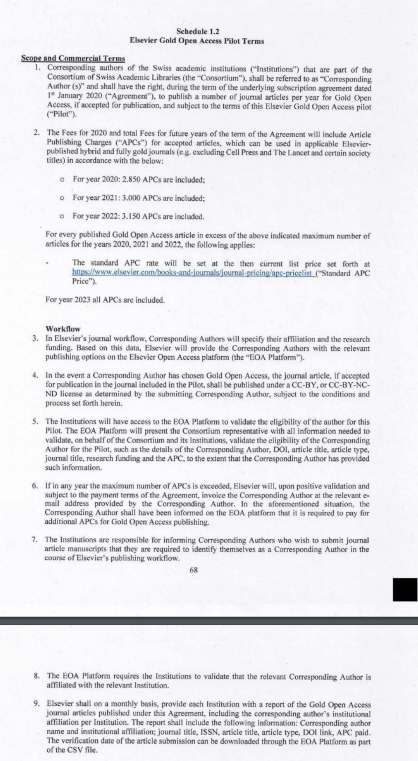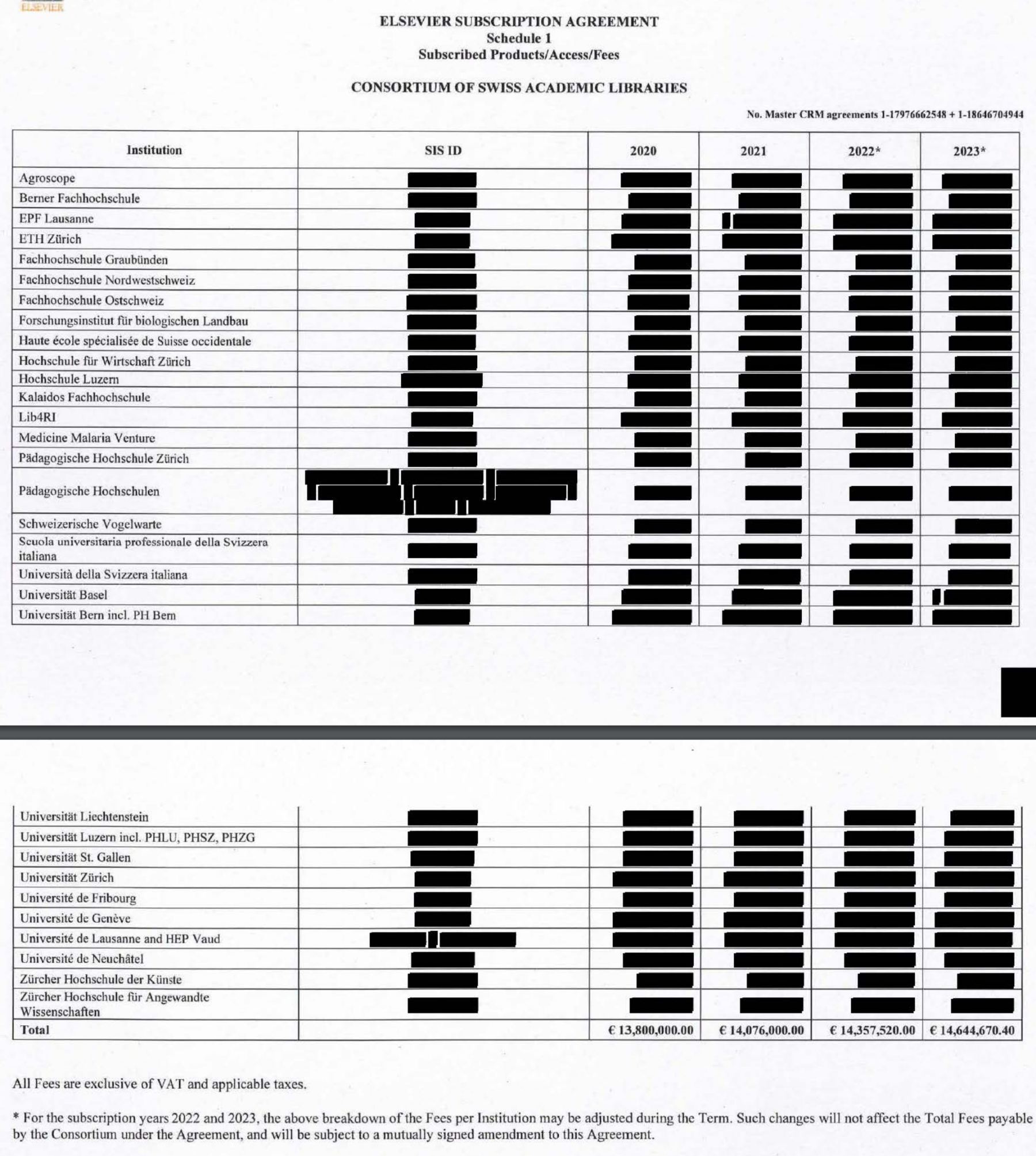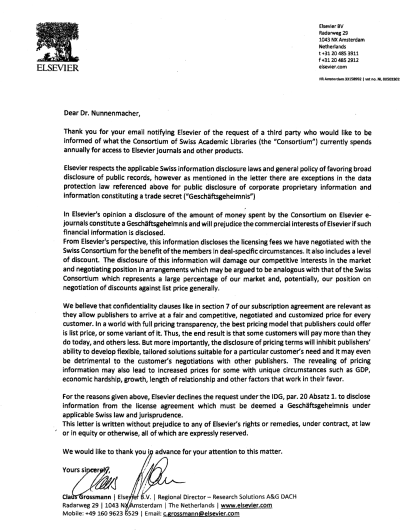Swiss € 57million Elsevier deal
A first critical evaluation after 8 months
The swissuniversities Read & Publish Agreement with Elsevier applies to publications submitted to Elsevier from 1 January 2020. However, the agreement and the list of relevant journals were not officially communicated until the end of May 2020.
Big Deal with an OA Addendum
The contract reads at first like a classic big deal for journal subscriptions. The Swiss universities once again allow themselves the luxury of 4 years' access to Elsevier’s entire journal portfolio. Only a short addendum of 1.5 pages deals with the new OA workflow.
Accordingly, all authors of the participating institutions (all Swiss universities, as well as Agroscope, FIBL, the University of Liechtenstein and the Swiss Ornithological Institute) can publish in the hybrid and Gold OA programme of Elsevier Open Access :
| Year | APCs included | Price Read-and-Publish | PAR-fee 1 |
|---|---|---|---|
| 2020 | 2850 APCs | 13.8 Mio EUR | 4842 EUR |
| 2021 | 3000 APCs | 14.1 Mio EUR | 4692 EUR |
| 2022 | 3150 APCs | 14.4 Mio EUR | 4558 EUR |
| 2023 | Unlimited (all you can publish) | 14.6 Mio EUR | ? |
During the first three years, a certain number of APC’s are included. If in one year less is published than agreed, the quota expires. If more is published than agreed upon, Elsevier will inform the authors of this when they submit their articles and they can then decide whether they wish to pay the standard APC for Hybrid or Gold OA of the respective journal in addition to the agreement.
Included APC quota will hardly be exhausted in 2020.
For the year 2020 and the price of EUR 13.8 million, universities have a quota of 2850 APCs at their disposal. How many publications have already been published under the agreement can be found out from metadata at Elsevier( Jahn 2019).
Almost 400 publications have so far been published under the new Agreement on Open Access.
Even if one takes into account that it is not the publication date but the submission date that is relevant and that therefore publications from 2020 only become visible with a time delay until 2021, this figure is surprisingly low. With around 30 publications per week, it is unlikely that the quota will be reached.
Too many papers are not in the agreement
As the cross-check shows, many articles of the institutions involved are currently not published via the agreement. There are almost 400 of such Corresponding Author Papers. 75% are published in journals that are on the list of the agreement. Among those, there are 196 “Full-length Papers”, that I would have expected to be covered by the agreement. So either the universities reject many of the papers (see workflow) or Elsevier does not identify and propose the papers for the agreement at all.
Furthermore, there are over 650 papers for which there is a “Swiss” co-author, but not a corresponding author. These papers are excluded from the agreement.
Overall, it must therefore be stated that as of date (August 2020) of the at least 1450 “Swiss” papers submitted to Elsevier and published since 1.1.2020, only 27% have become freely accessible through the new Read & Publish Agreement.
Mirror Journals
The agreement has already led to the publication of 10 articles in the so-called mirror journals. Here, swissuniversities would have done well to agree that Swiss Corresponding Papers should be published in the original journal and not in the mirror journal. Once again, Elsevier’s impudent strategy of delaying the flip to OA with the introduction of the mirror journals worked well.
Double Dip: Hybrid + Agreement
There are also cases in which the hybrid costs were not paid via the agreement, but very probably via an additional invoice to an insitute of the participating insitution. I know this for sure in this example: http://doi.org/d6gt
If the quota is not used up, such cases of double payment are particularly annoying as they represent the new type of double dip.
Only 42% CC-BY
Furthermore, it is a design flaw that swissuniversities has not defined centrally, that articles published via the agreement always will have a CC-BY license. By leaving this choice to the authors, 58% of OA articles now have a CC-BY-NC-ND license, which is not compatible with the Berlin Declaration, which was signed by swissuniversities and the individual universities.
No quality requirements
It is also annoying that swissuniversities has failed to set clear quality standards. Be it in terms of content (e.g. transparency in peer review or the publication of peer review reports) or formally, such as the deleivery of complete metadata. Elsevier deliberately refuses to expose citation data via Crossref, despite this being the industry norm. Elsevier also does not expose affiliations or abstracts to Crossref.
Half-hearted transparency
And then there is the tiresome issue of transparency. Although the contract was made accessible in large parts, it was decided to remain intransparent again about the cost specific to the individual institution:
Despite many clear decisions from former FOI requests, most universities have refused to answer my inquiries. The arguments of Elsevier are often adopted uncritically in their responses:
Instead of creating transparency with a 10-minute effort, many universities (e.g. PHZH, ZHAW, UZH, UniFR, ZHDK, Lib4RI) deliberately are provoking proceedings whose outcome will be decided against them. After all, there are also some institutions (e.g. UniSG, ETHZ, Agroscope, EPFL) that can still weigh up the public’s need for transparency against purely commercial interests and have disclosed the figures after a long processing time.
Conclusion
Anyone who has been following me activity knows I have repeatedly advocated for Read & Publish Agreements as a realistic way to OA (e.g. here)
The fact that my demand eventually has been implemented, makes me only halfway satisfied. The agreement comes years too late and in an environment where the parameters have already changed significantly again (e.g. Sci-Hub, Plan S, Elsevier Cancellation in Germany and in other countries).
Unfortunately, you can see from the agreement how it was reached. The Swiss negotiating delegation was held up for a very long time by Elsevier, only to agree to something half-baked shortly before the end of 2019. Obviously the negotiation team had not the courage to cancel the subscriptions, like they did (at least for a moment) for Springer Nature.
Particularly disturbing is the fact that a 4-year contract was signed right away. Why not start with a 1-2 year contract in order to gain experience and to be able to correct any undesirable developments, like those which now come apparent? Now, swissuniversities has given up all its trump cards for four years and may soon have to advertise hybrid OA Elsevier if the publication volume does not develop as anticipated. It would actually be desirable if fewer Swiss authors were to publish in hybrid journals from Elsevier, but in genuine Open Access journals. The signal that this agreement sends out to genuine Gold Open Access publishers is also fatal. Without a public call for tenders, Elsevier has been awarded a mega-contract, while those publishers who have actually been striving for OA for years and can deliver it more cheaply will be left out in the cold.
With a PAR fee of over 4500 EUR, the price level is already extremely high, which once again shows that OA in Switzerland does not fail because of the lack of money.
The money has now been used to buy 30% OA from Elsevier. But for the 100% that swissuniversities wants to achieve by 2024, a lot still has to happen.
-
The PAR-fee (Read and Publishing fee) is a very rough indicator, which shows how much money is spent for the APC and the still existing read access per article (For example in Germany the PAR-fee for Wiley is 2750 EUR) ↩︎


